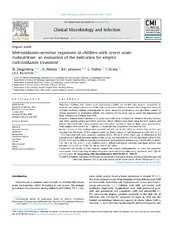| dc.contributor.author | Zangenberg, Mike | en_US |
| dc.contributor.author | Abdissa, Alemseged | en_US |
| dc.contributor.author | Johansen, Øystein Haarklau | en_US |
| dc.contributor.author | Tesfaw, Getnet | en_US |
| dc.contributor.author | Girma, Tsinuel | en_US |
| dc.contributor.author | Kurtzhals, Jørgen Anders Lindholm | en_US |
| dc.date.accessioned | 2020-08-11T08:43:58Z | |
| dc.date.available | 2020-08-11T08:43:58Z | |
| dc.date.issued | 2020 | |
| dc.Published | Zangenberg, Abdissa A, Johansen ØH, Tesfaw G, Girma, Kurtzhals. Metronidazole-sensitive organisms in children with severe acute malnutrition: an evaluation of the indication for empiric metronidazole treatment. Clinical Microbiology and Infection. 2020;26(2):255.e7-255.e11 | eng |
| dc.identifier.issn | 1198-743X | |
| dc.identifier.issn | 1469-0691 | |
| dc.identifier.uri | https://hdl.handle.net/1956/23635 | |
| dc.description.abstract | Objectives: Children with severe acute malnutrition (SAM) are treated with empiric amoxicillin or penicillin and gentamicin because of the high risk of severe infections. Experts have suggested, based on available evidence, adding metronidazole to cover anaerobic bacteraemia and diarrhoea caused by Giardia duodenalis or Clostridium difficile. The objective of this study was to assess the importance of these infections in children with SAM. Methods: Children from 6 months to 15 years with SAM were enrolled and followed clinically. Aerobic and, when patient weight permitted, anaerobic blood cultures were done using Bactec® system, and isolates identified with matrix-assisted laser desorption ionization–time of flight mass spectrometry. Stool samples were tested for C. difficile, G. duodenalis and Entamoeba histolytica by PCR. Results: A total of 334 children were enrolled and 174 out of 331 (53%) for which data on this was available had diarrhoea. Of 273 patients tested by blood culture, 11 had bacteraemia (4.0%, 95% CI 2.3–7.1%) but none with strict anaerobic bacteria (0/153, 95% CI 0–2.4%). There was no difference in the prevalence of C. difficile between children with (5/128, 4%) and without (7/87, 8%) diarrhoea (OR 0.47, 95% CI 0.14–1.53), and no difference in the prevalence of Giardia between these groups (78/138, 60% vs. 46/87, 53%; OR 1.34, 95% CI 0.77–2.32). Children with C. difficile had higher mortality than those without this infection (3/11, 27%, vs. 7/186, 4%; OR 43, 95% CI 3.9–483). Conclusion: Our results do not provide support for empiric metronidazole to cover for anaerobic bacteraemia. Trials evaluating the effect of empiric treatment and its effect on G. duodenalis and C. difficile are warranted. | en_US |
| dc.language.iso | eng | eng |
| dc.publisher | Elsevier | eng |
| dc.rights | Attribution-NonCommercial-NoDerivs CC BY-NC-ND | eng |
| dc.rights.uri | http://creativecommons.org/licenses/by-nc-nd/4.0/ | eng |
| dc.title | Metronidazole-sensitive organisms in children with severe acute malnutrition: an evaluation of the indication for empiric metronidazole treatment | en_US |
| dc.type | Peer reviewed | |
| dc.type | Journal article | |
| dc.date.updated | 2019-12-06T13:08:49Z | |
| dc.description.version | publishedVersion | en_US |
| dc.rights.holder | Copyright 2019 The Author(s) | |
| dc.identifier.doi | https://doi.org/10.1016/j.cmi.2019.05.022 | |
| dc.identifier.cristin | 1704364 | |
| dc.source.journal | Clinical Microbiology and Infection | |

